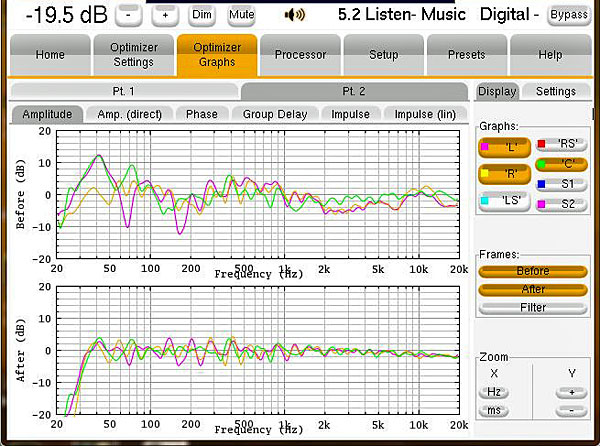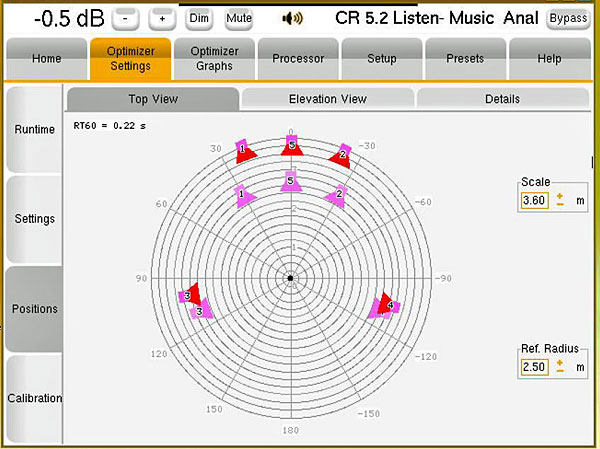| Columns Retired Columns & Blogs |
Very nice write up, Kal. Yes, you are correct, in that, any venue is only as good as its inherent acoustical space. One such magical place that comes to my mind is, L'Olympia Theatre in Paris, France.
Fourth, a myriad of other manual adjustments—a 31-band graphic equalizer, and level and delay controls—let the user tweak input and/or output signals to taste. This, too, is doable on the fly—you can hear the effects of the changes as you make them.
Finally, in addition to the OSD output driven directly from the MC Processor's DVI/HDMI or VGA outputs, connecting the Trinnov to one's home network via Ethernet grants access to the OSD and all operations via a VNC (Virtual Network Computing) viewer using any computer or tablet on your network—or even remotely, via the Internet. I used my Apple iPad most of the time, but the Internet route would allow me to control and monitor the Trinnov from anywhere.
As it turned out, VNC access via the Internet is essential—although the Optimizer came with a detailed Reference Manual that's common to all configurations, there is no instruction or user's manual at all. Sure, all the info is in the Reference Manual, and it's sufficient for hooking it up properly. But a new user such as I needs a step-by-step guide to getting things going. Here's where Curt Hoyt came in.
With the OSD on my plasma (or iPad) and Hoyt on the phone, I watched as he guided me through the basic features of setup, calibration, and tweaking: he executed the steps and I moved the mike in my Connecticut listening room. Not only that, I got a basic education in the arts of equalization and acoustics, as Hoyt patiently explained why we were performing each step. After two long days of sessions, I was confident enough in using the system to fiddle with it on my own. Sure, reviewers usually get nice treatment from manufacturers—but, as Hoyt often assured me, every purchaser of a Trinnov processor can expect from him the same sort of help and training he gave me. I contacted some other users, who confirmed this. Still, a genuine user's manual would be much appreciated.
Using the Optimizer
The MC Processor was fed with the XLR analog outputs of my Marantz AV-8801 A/V preamplifier so that I could have access to all my usual sources. For this, I turned off Audyssey, bass management, and even individual channel-level and -delay settings. For this input, I used the Trinnov's analog input converter at 24-bit/96kHz (footnote 3). In addition, I used my old Oppo DV-980H DVD player, which I'd had modified (by Shawn Fogg) with the addition of three S/PDIF outputs, and connected all three directly to the Trinnov's three digital inputs. The MC's XLR analog outputs were connected to my two subs, and to the five-channel Bryston 9BSTT power amplifier that drives my main speakers. The Trinnov's menus permit the routing of any input to any output, but Hoyt and I stuck with the obvious channel mapping. My speakers at the time comprised Paradigm Studio20/v2s for the surrounds, a Paradigm Studio 60/v3 for the center channel, and, because I'm in the process of reviewing them for the November 2013 issue, a pair of Sonus Faber Venere 2.5s for the front L/R channels. This obvious mismatch places an even greater demand on any EQ system or listener.
Although I performed a number of calibrations using a handful of microphone positions and target curves, almost all the listening I report on here is based on my usual listening position and a relatively flat target curve with a smooth treble rolloff beginning at 2kHz that goes to –2dB at 20kHz (footnote 4). This appeared in the Trinnov's menu as "CR 5.2 Listen Music Analog" and as "CR 5.2 Listen Music Digital" for the two input options. Curt Hoyt also inserted a "Bypass" option so that I could A/B the effect of the Optimizer's corrections.
It was immediately apparent that the resulting sound, especially when compared to Bypass, was as balanced and smooth as my system has ever sounded. I could not easily A/B it with Audyssey for technical reasons, but I was certain that the Trinnov Optimizer had the advantage in producing a seamless front-and-side soundstage while retaining bass power and a detailed but nonfatiguing treble. Playing a pink-noise signal through each speaker in turn revealed that all five shared an uncommon tonal similarity, something difficult to achieve even with all identical speakers placed in different room positions (fig.1). Remember, I was using the Sonus Fabers for L/R and two different Paradigm models for the rest—believe me, without the Optimizer, they did not sound at all alike.

Since the Optimizer permits on-the-fly implementation or defeat of EQ, levels, and delays, it was clear that the EQ (which Trinnov calls Acoustics Correction) was the major contributor to the improved sound; defeating the level or the delay settings, or both, only moved the soundstage a bit forward or back. Defeating the EQ was nearly the equivalent of Bypass: a brasher, boomier sound with a somewhat inconsistent soundstage. The stability of central imaging with two-channel signals was greatly enhanced by the Optimizer.
I particularly noted this with choral recordings, such as Duruflé's Requiem, with Bill Grayston Ives conducting the Magdalene College Choir Oxford and the English Sinfonia (SACD/CD, Harmonia Mundi HMU 807480). The chorus had a generous size and spread, but, as in a concert, one could often focus one's attention on individual voices. With really immersive recordings, such as the spectacular Rupa-khandha, by the Los Angeles Percussion Quartet (BD+CD, Sono Luminus DSL-92150), the instruments in the surround channels were as full-bodied and balanced as those in the fronts, and all occupied a consistent sound space. Since the Optimizer was, per necessity, subjecting the analog input to additional A/D/A conversions, it was no surprise that running signals directly via the Oppo's digital outputs offered a small but easily audible advantage in detail and a lower level of background noise. SACDs, such as Pink Floyd's Dark Side of the Moon (EMI 582136-2), were equally spacious, but seemed just a bit more defined and incisive without the reduncdant conversions.
But that wasn't all. The Optimizer's secret sauce is its unique 2D and 3D remapping capability. When I reviewed the Sherwood R-972, I examined its claimed ability to vertically remap a low-placed center speaker to the same acoustic height as the front L/Rs and the screen, or to remap the entire speaker array for a second, off-center seating position. It did both, but at a price: low-level but distracting signals were now audible from the other speakers, especially the surrounds, which, in my room, are physically much closer to the main listening position than the other speakers. I preferred to leave the remapping off.
When I look at the elevation and plan maps of my speakers in the Optimizer (fig.2), they're all at nearly the same height, but the fronts are a bit too far from the main listening position and the rears a bit too far forward, compared with ITU recommendations. Even the perspicacious Curt Hoyt thought it wasn't bad. I had little tolerance for the remapping in the Sherwood R-972's version of Optimizer because the corrective signals were so obvious. In testing the MC Processor's 2D and 3D options with a two-channel source, so little corrective signal was injected into the surround and center channels that I had to put my ears almost to the grillecloths to hear it. With stereo sources of varied quality, the 2D remapping made the front soundstage seamless, with excellent center fill and rock-solid center imaging.

With multichannel sources, even the subtle correction signals were completely masked by the regular channel output. Switching on the 2D remapping caused the front soundstage to recede a bit from me, though it remained continuous with the surround ambience. At first I thought this inconsequential, but with a Blu-ray one can actually see the performance and relate it to what one hears. Using the wonderful BD of a concert performance of the Fauré Requiem, with Paavo JÑrvi conducting the Orchestre de Paris and Chorus (BD, Euroarts 2058874), it was clear that the sound with 2D remapping better matched what I saw onscreen. Moreover, that slight shift in apparent distance seemed to entirely disconnect the soundstage from the positions of all of the speakers.
I didn't have a visual guide for Tchaikovsky's Manfred Symphony, with Dmitri Kitayenko and the Cologne Gürzenich Orchestra (SACD/CD, Oehms OC 665), but this—like Kitayenko's recordings of other symphonies, by Tchaikovsky (Oehms) and by Shostakovich (Capriccio), and Markus Stenz's series of Mahler symphonies (Oehms)—have a distinctive sound characterized by a broad, deep soundstage with a strong midbass and low end—and I don't need video to tell me that they sound great. Still, 2D remapping had the effect of creating a greater coherence of front and surround images.
The Optimizer's 3D remapping did little for me, but 2D became a default for all listening. Its only failure was with TV audio, particularly from local stations, whose mike techniques are unpredictable. Then, it took but a couple of taps on the iPad to defeat it.
Overall, the superior abilities of Trinnov Audio's Optimizer to measure and equalize my surround system and correct for imperfect speaker placements were revelations. It was reminiscent of my first experiences with Audyssey MultEQ, but this reached another, higher level. The frequency-domain balance, the generous and continuous soundstage, and the solidity of the central and peripheral imaging approached what I hear from my Manhattan system, with its superior room and much more expensive equipment. Indeed, if I could A/B the two, I suspect that, with the Trinnov Optimizer, this more modest setup might satisfy me just as much. The Trinnov devices aren't inexpensive, but considering the degree of improvement they offer, I think they're worth every penny.
Footnote 4: We also created a movie target curve, which added another 2dB to the treble rolloff and a 4dB bump at 100Hz and below, which rose from the flat curve below 200Hz.

Very nice write up, Kal. Yes, you are correct, in that, any venue is only as good as its inherent acoustical space. One such magical place that comes to my mind is, L'Olympia Theatre in Paris, France.